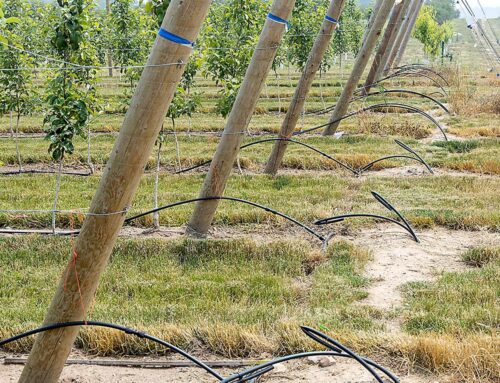Probably the most sought-after apple tree right now is a Royal Red Honeycrisp budded on a Geneva 935 rootstock. Get in line and be prepared to wait four to five years.
That’s the assessment made by Wanda Heuser Gale, who works for Lawrence, Michigan-based Summit Tree Sales and is president of International Plant Management.
The companies work with nurseries in helping them identify and develop promising new varieties and with growers to help them procure trees from nurseries.
“Nurseries are pretty well booked up to 2017,” she said.
“I see no signs of it abating,” she said of the apple tree planting boom that has been going for several years now. “There are no real signs, just a few whispers,” as some growers worry that the wonderful new varieties that have fueled the planting fever may be overplanted. Gale sees no real sign of that happening either.
“Are there too many Honeycrisp? We’re nowhere near that,” she says, answering her own question.
But demand for the original Honeycrisp apple has fallen off as new, redder strains have been discovered. Growers in the West have especially spurred demand for redder strains of Honeycrisp—the Royal Red from Willow Drive Nursery, which Gale calls “the best so far of three or four redder strains,” but also Firestorm from Cameron Nursery.
Growers in the upper Midwest are able to get good color on the original Honeycrisp, but in warmer climates like the West, it’s more difficult. Even though the new strains don’t seem to contain improvements other than color, the eye appeal wins out. Red Honeycrisp is “the big red elephant in the room,” she said.
“The market always goes redder,” she added. “Growers who get a redder packout get better money. That’s a fact.”
While she says she has no hard numbers on trees being bought and planted, she guesses that Honeycrisp is probably the best seller now, edging out Gala. “Demand for Gala is still huge,” she said.
Part of the demand explosion is caused by growers planting four times as many trees per acre as they used to, so tree demand isn’t a sign of acreage expansion. It’s just that a thousand trees plant an acre now where once they planted four or five acres.
“Budwood is always the limiting factor with new strains,” she said, “but there has been a real shortage of rootstocks, too.” There don’t seem to be enough Malling 9-sized rootstocks, and promising new rootstocks, like the Geneva series, have been slow coming to market.
“People want to plant trees on the Geneva rootstocks,” Gale said, “but the supply is even tighter. They’re booked out three, four, five years.
“The western growers want the Geneva rootstocks because several are resistant to replant disease, which is a huge problem in the West,” she said. “In the East, growers are looking for fire blight resistance,” another trait the Geneva stocks were bred to address.
Some issues—such as brittleness at the graft union—have emerged with some cultivars on some Geneva rootstocks. “It takes fifty years to prove a rootstock,” Gale said. “Nothing is perfect. Everything has an issue. Thirty years ago, everybody wanted a freestanding tree, so they planted on M.7 and thought that was great. We’re always fine-tuning mistakes.”
Matt Moser at Moser Fruit Trees Sales in Coloma, Michigan, is, like Summit Sales, a broker of fruit trees. He works with growers who are looking for trees, and he agrees with Gale, they’re hard to come by.
Labor
Some forces that should be at work are probably slowing planting down somewhat, he said.
Growers are concerned more every year about the shortage of seasonal labor, which will continue to get worse if there is no action to address the situation with undocumented workers. “The long-promised immigration reform does not seem to be coming,” he said.
Still, growers continue planting apples, partly because the high-density systems allow for partial mechanization using platforms and make labor more efficient by taking ladders out of the orchards.
Growers want to plant the newer, better coloring strains of Gala, such as Buckeye but especially Gale, he said. A key reason is to reduce the number of picks required based on color development.
Aztec and Banning Fuji are preferred choices because they are more cherry red and less muddy in color than the original Fuji or BC 2 red.
“All the nurseries are looking at red strains of Honeycrisp,” he said. “Willow Drive is working with both Van Well and C&O to produce more of Royal Red.”
Consumers love Honeycrisp, but growers are unhappy about how difficult they are to grow. “Are the new strains less difficult? We don’t know yet,” he said.
Jonagold has picked up in popularity. “There are some nice-coloring ones,” Moser said, naming Red JonaPrince and Jonastar in particular.
Will club apples do well?
“Some of them will have legs,” he said. “Ambrosia is one. I’m not sure how well SweeTango is going. EverCrisp is looking good, and it seems easier for growers to get involved.” People who want to grow that variety merely need to join the Midwest Apple Improvement Association and pay the royalty fees on the trees to be part of that club.
Moser operates both his fruit tree brokering business and an online business for backyard growers called Grandpa’s Orchard. He grows about 250 heirloom varieties from which he buds trees and offers them on speculation.
“There is a growing interest in hard apple cider varieties,” he said. “I want to get more involved in that. That industry is exploding, too.” •






Leave A Comment